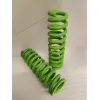Jan. 06, 2024
Automobiles & Motorcycles
Coil springs play a crucial role in various mechanical systems, from automotive suspensions to industrial machinery. Technicians dealing with these components should possess a foundational understanding of their design, functions, and common considerations. Here's what every technician needs to know about coil springs:
1. Basics of Coil Spring Design:
Wire Diameter: The thickness of the spring wire.
Outer Diameter (OD): The overall diameter of the coil.
Inner Diameter (ID): The diameter of the central opening within the coil.
Active Coils: The number of coils that contribute to the spring's deflection.
2. Materials Used:
High Carbon Steel: Commonly used for its durability and cost-effectiveness.
Stainless Steel: Resistant to corrosion, suitable for applications in harsh environments.
Alloys: Offer specific performance characteristics, catering to diverse applications.
3. Load and Compression:
Load Capacity: The maximum force a coil spring can endure without permanent deformation.
Compression: The spring's ability to compress and return to its original shape under an applied load.
4. Types of Coil Springs:
Compression Springs: Absorb and store energy when compressed.
Extension Springs: Absorb and store energy when stretched.
Torsion Springs: Store energy when twisted or torqued.

5. Spring Rate and Stiffness:
Spring Rate (k): The amount of force required to compress or extend the spring by a unit distance.
Stiffness: A measure of how resistant the spring is to deformation.
6. Dynamic and Static Loading:
Dynamic Loading: Springs subjected to varying loads during operation.
Static Loading: Constant or unchanging loads on the spring.
7. Environmental Considerations:
Corrosion Resistance: Essential for applications exposed to moisture or corrosive substances.
Temperature Sensitivity: Some materials may exhibit changes in performance under extreme temperatures.
8. Common Failure Modes:
Fatigue: Gradual wear and failure due to repeated loading and unloading cycles.
Overloading: Exceeding the spring's load capacity, leading to permanent deformation.
Corrosion: Deterioration of the spring material due to exposure to corrosive elements.
9. Installation and Maintenance:
Proper Installation: Ensures correct alignment and functioning within the system.
Regular Inspection: Detects signs of wear, corrosion, or fatigue, allowing for timely replacement.
10. Applications Across Industries:
Automotive: Suspension systems, shock absorbers.
Manufacturing: Machinery, industrial equipment.
Aerospace: Landing gear, control systems.
11. Safety Considerations:
Potential Energy Release: Exercise caution when handling compressed coil springs.
Proper Equipment: Use appropriate tools and equipment for installation and removal.
By mastering these fundamental aspects of coil springs, technicians can troubleshoot, maintain, and optimize systems where these components are integral. A solid understanding of coil springs is essential for ensuring safety, longevity, and optimal performance in various technical applications.
If you are interested in sending in a Guest Blogger Submission,welcome to write for us!
All Comments ( 0 )